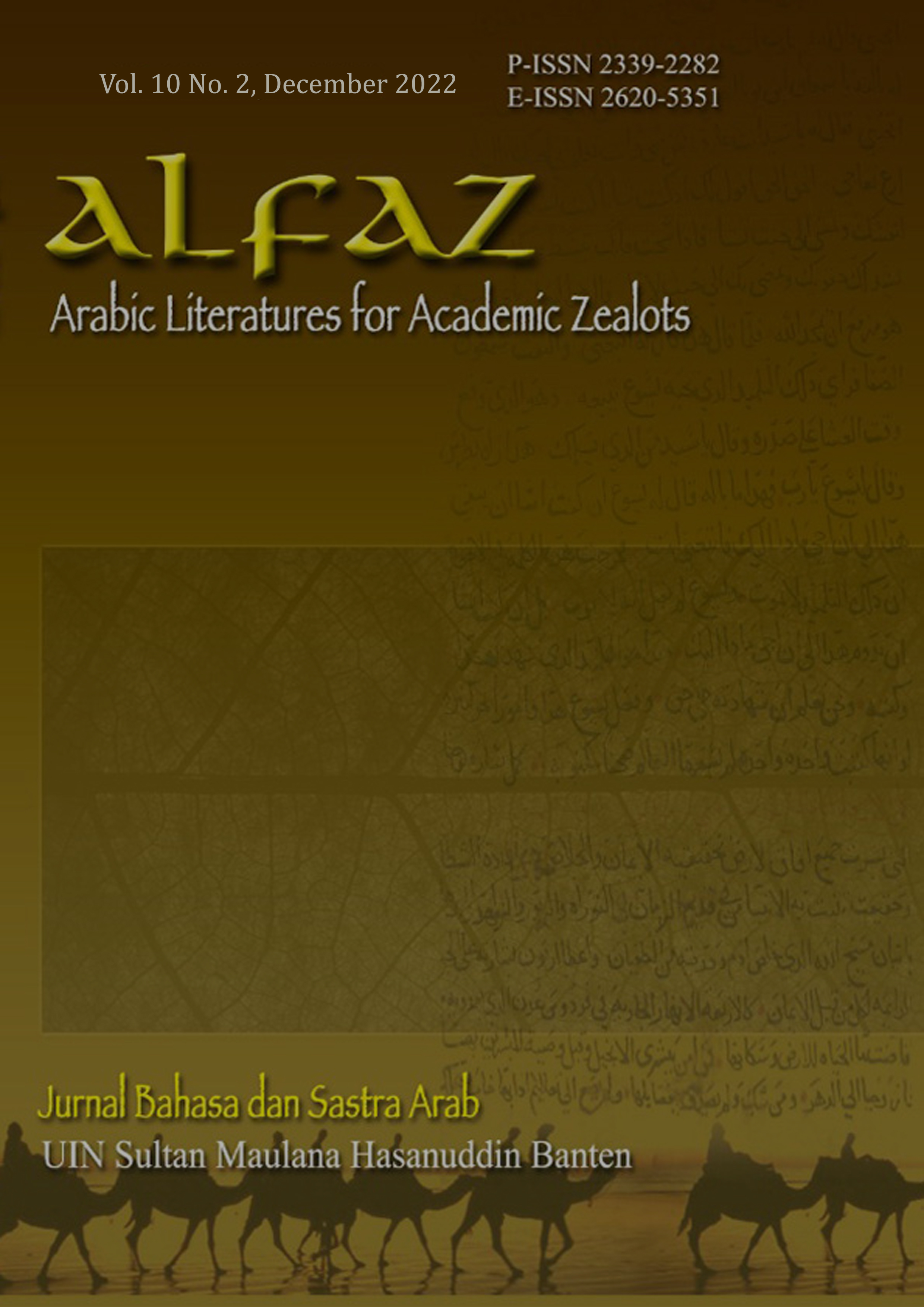Al-insya’ Atholabi Fi Surat Al-Hujurat (Dirasah Tahliliyah Balaghiyah)
DOI:
https://doi.org/10.32678/alfaz.Vol10.Iss2.9064Keywords:
Pattern Insya Thalabi, Al-Quran, Letter Al-HujuratAbstract
Some students face difficulties in understanding the meaning of the Quran in the form of insya thalabi with various meanings that vary based on the context of the verse, sometimes a verse with a pattern of commands but the meaning is not an order but advice, prayer or instructions etc. The purpose of this study was to determine the pattern of insya thalabi and its meaning in Surat al-Hujurat. The type of this research is library research, the data sources in this research consist of primary sources in the form of al-Qur'an al-karim surah al-hujurat and secondary sources in the form of books related to the research theme such as interpretation books, balagah and dictionaries. The research data were analyzed using Balagah descriptive analysis. The results showed that there were 34 insya thalabi in the letter al-hujurat, 16 in the form of amr, 9 in the form of nahi, two in the form of istifham, 6 in the form of nida and 1 in the form of tamanni. As for the meaning of 34 insya thalabi, it is divided into two kinds, namely the essential meaning and the meaning of balaghi. The meaning of balaghi in insya thalabi letter al-hujurat is al-tahdid, al-nuskhi, al-irsyad, al-khusi, al-tasyji', al-khabar, al-tahdid, al-taqrir, al-inkar, al-tamanni li al-wuqu'.
Downloads
References
Al-Jarum, Ali, Wa Mustofa Amin. Al-Balaghah Al-Wadhihah Al-Bayan Al-Ma’ani Al-Badi’. Dar Al-Ma’arif, 4780/1999.
Al-Jarum, Ali, Wa Mustofa Amin. Al-Balaghah Al-Wadhihah Al-Bayan Al-Ma’ani Al-Badi’. Jakarta: Raudhah Faris, 1427.
Al-Harbi, Abdul Aziz bin Ali, Al-Balaghah Al-Muyassarah. Lebanon: Dar Ibn Hazm, Bairut, 1432/2011.
Zadam, Su’ad. “Dalaltil Asalib Al-Insya’iyah Fil Qur’an Al-Karim Annida’ Anmudzyajan.”, Risalah Addukturah, Jami’ah Wahran 1 Ahmad bin Ballahk 2018-2019.
Akkari, In’am Fwwal. Al-Mu’jam Al-Mufassal Fi ‘Ulum Al-Balghah, Al-Badi’ wa Al-Bayan wa Al-Ma’ani. Lebanon: Dar Alkutub Al-‘Ilmiyah, Bairut, 1418/1996.
Inayatullah Fera Lidiya Putri.”Al-Kalam Al-Insyai’ Atholabi fi Surat Asyuara’ fi Al-Quran Al-Kari: Dirasah Tahliliyah Balaghiyah.”Arrisalah Linail Syahadah Addarajh Al-ula, Jami’ah Sunan Ampel Al-Islamiyah Al-Hukumiyah Surabaya-Indonesia, 1432/2018.
Almayi’, Khalil Abdul Mu’thi. “Usluban Al-Amr wa Annahi fi Surat Al-Maidah: Dirasah Dalaliyah.”Majjalah Adab Dzi Qar Kuliyyat Al-Adab min Qism Allughoh Al-Arabiyah Bijami’at Bishrah, Al-Adad 5, Al-Mujallad 2, Arraqm 9, 2012, 98-100. Attawsul 5 Yanayir, 2022.
https://search.emarefa.net/detail/BIM-304297
Naof Al-Qatati, Maryam Yahya. “Al-Asalib Al-Insya’iyah fi Juz Al-Ahqaf: Dirasah Uslubiyah.”Risalah Majister, Jami’ah Al-Aqsha Bighazzah, 1432/2017.
Al-Hashimi, Assayid Ahmad, Jawahir Al-Balaghah, fi Al-ma’ani wa Al-Bayan Al-Badi’, Almaktabh Al-‘Ashriyah, Syaida-Bairut,1999.
Amiruddin dan Zainal, Asikin. Pengantar Metode Penelitian Hukum, Jakarta: Raja Grafindo Persada, 2006.
An-Nisa, Miftakhurifka, Aulia Subita, Meidias Abror Wicaksono. “Bentuk amr dan nahi dalam surat al-hujurat.” Prosiding Konferensi Nasional Bahasa Arab VII, universitas Negeri Malang Jurusan sastra arab-Fakultas sastra, Malang 9 Oktober, 2021.
Aras, Shiddiq M, Sriwahyuningsih R Saleh. “Asalib al-Insyaiyyah fi Juzi Samaniyah wa ‘Isyrin.” ‘A Jami: Jurnal Bahasa dan Sastra Arab, Vol 10, No 2, September 2021, 335-347. Diakses pada 5 Januari 2022, http://dx.doi.org/10.31314/ajamiy.10.1.230-242.2021.
Nawawi, Ismail. Metode Penelitian Kualitatif. Jakarta: CV Dwiputra Pusaka Jaya, 2012.
Rianto, Adi. Metodologi Penelitian Sosial dan Hukum, Jakarta: Granit, 2004.
Sukmadinata, Nana Syaodih, Metodologi Penelitian Pendidikan. Bandung: PT Remaja rosdakarya, 2010.
Trianto, Pengantar Penelitian Pendidikan Bagi Pengembangan Profesi Pendidikan dan Tenaga Kependidikan. Jakarta: Kencana, 2010.
Zed, Mestika. Metodologi Penelitian Kepustakaan. Jakarta: Yayasan Obor Indonesia, 2008.
Downloads
Published
Issue
Section
License
Copyright (c) 2023 Nadhif Nadhif

This work is licensed under a Creative Commons Attribution-NonCommercial-ShareAlike 4.0 International License.
Authors retain copyright and grant the journal right of first publication with the work simultaneously licensed under a CC BY NC SA License that allows others to share the work with an acknowledgement of the work's authorship and initial publication in this journal.







